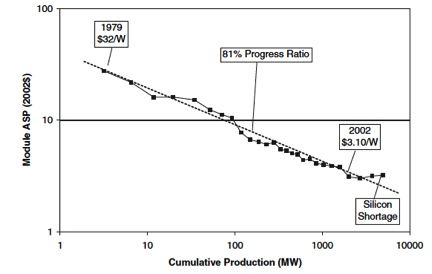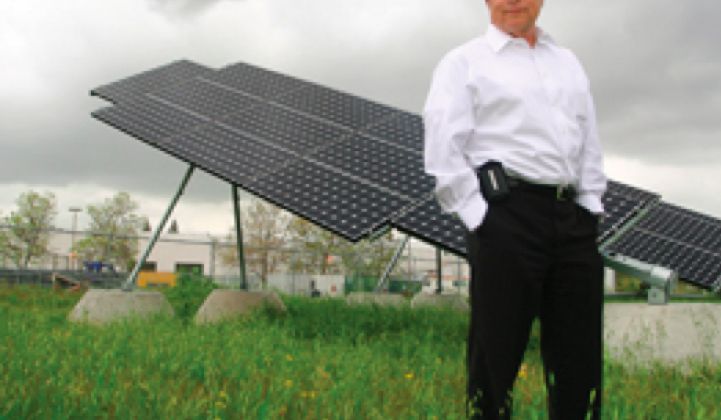There is a very consistent relationship between the cost of solar PV panels and the deployment of solar PV panels. This relationship is known as Swanson’s law, named for Richard Swanson, the founder of SunPower and author of a paper on this topic. The law states that with every doubling of production and shipments of panels, there has been a 20 percent reduction in the cost of panels.
Here’s the chart from Swanson’s 2006 paper.
FIGURE 1: Swanson’s Law

Source: Swanson's 2006 paper
Since that paper was published, the industry’s learning curve kicked in even more dramatically, as highlighted in a nice overview article in the Economist magazine in 2012.
What this relationship shows is that we are well on our way to seeing solar panels cost almost nothing -- and there is no hyperbole in this statement. This is part of a broader trend highlighted in Jeremy Rifkin’s insightful new book, The Zero Marginal Cost Society: The Internet of Things, the Collaborative Commons and the Eclipse of Capitalism. It discusses the trend in many fields toward zero or near-zero costs brought about by the prosumer revolution and disintermediation (essentially, getting rid of the middleman). The idea is that consumers become producers as well as consumers (“prosumers”) through access to increasingly low-cost manufacturing equipment and other tools.
What Swanson’s law doesn’t address, however, is the balance of costs of solar systems today represented by labor and “balance of system” equipment such as inverters, racking and wiring. Panel costs now account for a far less significant fraction of the total cost of a system than they did just a few years ago, making labor costs and balance-of-system costs more prominent. Moreover, panel prices across jurisdictions are very similar because we now have a global commodity market for solar panels.
Germany’s example is helpful for exploring this issue. Germany was the biggest market for solar for about a decade, only falling behind Japan, China and the U.S. in the last couple of years. The total cost of solar systems in Germany is far lower today than it is in the U.S., including panels, labor and balance-of-system costs, as described by the Lawrence Berkeley National Laboratory in a 2014 paper (Figure 2). In fact, the price through 2012 was half the price we pay in California, which is by far the largest U.S. market. This is a remarkable difference in cost that should prompt us to wonder why we’re overpaying so much for solar here in the U.S.
FIGURE 2: Median Installed Price of Residential PV Systems Sized Under 10 Kilowatts

Source: Lawrence Berkeley National Laboratory
A key message in the LBNL paper is this: getting to scale is the most important factor in bringing costs down. There are many other factors, however, that LBNL cite as important for bringing costs down, including streamlining permitting, lowering installation costs and reducing the costs of customer acquisition. Customer acquisition costs, the largest soft-cost category, also benefit from scale.
For example, the LBNL report states: “In addition, the large German market has transformed residential PV systems from an early-adopter product into a more mainstream product, and new customers are recruited primarily by word of mouth.” The report adds: “Peer effects in the diffusion of PV…further explain the relatively low customer acquisition costs in the more mature German market; about 1 of 32 German households owned PV systems in the first quarter of 2013 compared with 1 of 83 California households and 1 of 323 U.S. households.” In other words, it’s a virtuous cycle of scale enabling scale.
Unfortunately, in the U.S. we are still very much at an early-adopter state for solar. Solar penetration per capita is less than one-tenth in the U.S. compared to the situation in Germany. If we had as much solar installed in the U.S. on an equivalent basis as in Germany, we’d have about 150 gigawatts installed today, rather than the 16 gigawatts we currently have.
If the U.S. wants to see prices for solar comparable to those we’re already seeing in Germany, we should push for similar scales seen in Germany.
Getting to scale
There are a variety of potential paths to get to the scale required.
I’ve made no secret of my desire for the U.S. to pursue cost-effective (as in, no net cost for ratepayers) feed-in tariffs as the best policy to get to scale. The LBNL report cited above provides strong support for the value of FITs as a policy tool. The report states with respect to customer acquisition costs that “the relatively straightforward value proposition of PV systems under the FIT in Germany may further facilitate the sales process and contribute to lower customer acquisition costs compared to the United States.”
The LBNL report provides further support in its conclusion, stating: “To reduce [solar] costs, actors in the United States could consider policy reforms that enable a larger residential PV market with a stable growth trajectory while minimizing market fragmentation.”
A feed-in tariff is, of course, not the only policy that would provide scale, stability and minimized market fragmentation. However, given the additional benefits of simplicity and transparency that a well-designed and cost-effective FIT policy provides, it certainly stands out as the best contender.
Well-designed markets are also about transparency, longevity and certainty, as Deutsche Bank has stated in numerous reports on the German FIT experience. These features of well-designed FITs are described further in my article here. I like to add simplicity as another defining feature of beneficial energy policies, and FITs have that major benefit as well.
In sum, in terms of getting to scale in solar in the U.S., we’ve seen here that both equipment and soft costs benefit from scale. For the U.S. to see solar achieve its full potential, we need to push the market further in a virtuous circle of scale begetting scale. We don’t need subsidies at this point and that’s the really good news, at least not beyond the federal 30 percent Investment Tax Credit that I think should be continued at least through 2020.
What we do need is ambitious thinking at the state and federal levels as to how we can take advantage of grid-parity solar to achieve the transformation of our electrical system away from fossil fuels in a cost-effective and rapid way. And the very encouraging news that I’ve detailed in this column is that the more we do to promote solar, through smart policies that entail no net cost to ratepayers, the more we will see the costs of solar come down even further.
Under such policies, solar becomes a cost-saving -- not just cost-neutral -- proposition very quickly. The amazing thing is that not only will we save money by going solar on a large-scale, we also will enjoy the benefits of a far greener economy, increased jobs, increased energy independence and a more egalitarian distribution of profits from our energy production.
***
Tam Hunt is the owner of Community Renewable Solutions LLC, a renewable energy project development and policy advocacy firm based in Santa Barbara, California and Hilo, Hawaii.



